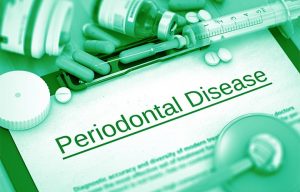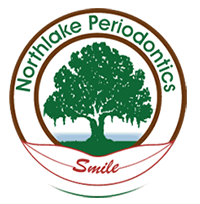PERIODONTAL DISEASE

What is Periodontal Disease?
Periodontal disease is a chronic, non-curable bacterial infection that requires ongoing therapy. When we achieve disease resolution, the patient is healed – not cured. The patient is never cured; the disease is just stabilized. Periodontal disease gradually destroys the supporting bone of your natural teeth. While there are many diseases which affect the tooth support structures, plaque-induced inflammatory lesions make up the majority of periodontal issues,and are divided into two categories: gingivitis and periodontitis. While gingivitis, the less serious of the diseases, may never progress into periodontitis, it does always precede periodontitis.
Dental plaque is the primary cause of gingivitis in genetically susceptible individuals.
Plaque is a sticky colorless film, composed primarily of food particles and various types of bacteria, which adhere to your teeth at and below the gum line. Plaque constantly forms on your teeth, even minutes after cleaning. Bacteria found in plaque produce toxins or poisons that irritate the gums. Gums may become inflamed, red, swollen and bleed easily. If this irritation is prolonged, the gums separate from the teeth causing pockets (spaces) to form. If daily brushing and flossing is neglected, plaque can also harden into a rough, porous substance known as calculus (or tartar). This can occur both above and below the gum line.
If gingivitis progresses into periodontitis, the supporting gum tissue and bone, that hold teeth in place, breaks down. The progressive loss of this bone, the alveolar, can lead to loosening and subsequent loss of teeth.
Periodontal disease is dangerous in that it is often painless and symptomless. 80% of Americans will be afflicted with periodontal disease by age 45, and 4 out of 5 patients with the disease are unaware they have it. It is important to maintain proper home oral care, particularly flossing and regular dental visits to reduce the risk

What is Periodontal Disease?
Periodontal disease is a chronic, non-curable bacterial infection that requires ongoing therapy. When we achieve disease resolution, the patient is healed – not cured. The patient is never cured; the disease is just stabilized. Periodontal disease gradually destroys the supporting bone of your natural teeth. While there are many diseases which affect the tooth support structures, plaque-induced inflammatory lesions make up the majority of periodontal issues,and are divided into two categories: gingivitis and periodontitis. While gingivitis, the less serious of the diseases, may never progress into periodontitis, it does always precede periodontitis.
Dental plaque is the primary cause of gingivitis in genetically susceptible individuals.
Plaque is a sticky colorless film, composed primarily of food particles and various types of bacteria, which adhere to your teeth at and below the gum line. Plaque constantly forms on your teeth, even minutes after cleaning. Bacteria found in plaque produce toxins or poisons that irritate the gums. Gums may become inflamed, red, swollen and bleed easily. If this irritation is prolonged, the gums separate from the teeth causing pockets (spaces) to form. If daily brushing and flossing is neglected, plaque can also harden into a rough, porous substance known as calculus (or tartar). This can occur both above and below the gum line.
If gingivitis progresses into periodontitis, the supporting gum tissue and bone, that hold teeth in place, breaks down. The progressive loss of this bone, the alveolar, can lead to loosening and subsequent loss of teeth.
Periodontal disease is dangerous in that it is often painless and symptomless. 80% of Americans will be afflicted with periodontal disease by age 45, and 4 out of 5 patients with the disease are unaware they have it. It is important to maintain proper home oral care, particularly flossing and regular dental visits to reduce the risk
